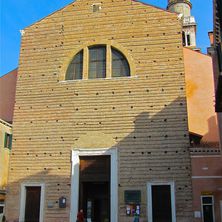

From the outside, the Church of Saint Pantaleon offers nothing to dazzle the eye. It was built on the site of a pre-existent church in the first half of the 18th century by an architect from Treviso, Francesco Comino. Its façade was never finished and it does not even occupy the predominant position on the eponymous campo, as most churches do. However, this dull and inconspicuous church possesses a truly remarkable work of art: the ceiling painting by Gianantonio Fumiani showing the Martyrdom and Apotheosis of St. Pantaleon.
St. Pantaleon was born in Nicomedia, in present-day Turkey, in 275 AD to a pagan father and a Christian mother. He studied medicine and became physician to Emperor Maximian. He was converted to Christianity by the Bishop of Nicomedia, who convinced him that Christ's prescriptions did more wonders for mankind than ordinary medicine. After seeing Pantaleon heal a blind man with his prayers to Jesus, his father was so impressed that he converted to his son's religion. When his father died, Pantaleon distributed all his wealth among the poor. Later he was denounced to Emperor Diocletian, who at first wanted to save him by having him repudiate Christ. However, not only did Pantaleon refuse, he healed a paralytic right in front of the Emperor. The emperor was outraged and ordered the Christian to be executed. But each time the executioners wanted to take his life, Christ would appear and thwart their plans: the sword would bend, the molten lead in a cauldron would become cold, the wild beasts that were supposed to devour him would run away, and so on. Finally, Pantaleon, after beseeching Heaven to forgive his murderers, submitted to his executioners' will and had himself beheaded. He is venerated in the Roman Catholic, Anglican and Orthodox churches.
Fumiani's painting in the Church of St. Pantaleon, executed between 1680 and 1704, though slightly monotone in color, is indeed a captivating sight. It measures 443 square meters and is surely the best example of tromp l'oeil painting in Venice. Looking up, we actually think that the pillars and windows of the church extend into the painting itself, making us direct participants in the event. So dramatic and vertiginous is this work that it is no wonder Fumiani fell to his death upon finishing it. More than capturing the last moments in the life of Pantaleon, the artist captured the last frenzied and agonizing moments of his own.
Another interesting artwork that is found in the church is Paolo Veronese's altarpiece, St. Pantaleon healing a boy. It is Veronese's last work, although it is nowhere as intense and colossal as Fumiani's ceiling.